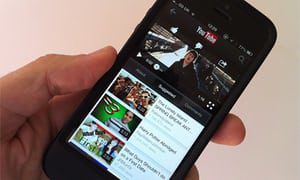
Last month on Media Network, a war of words broke out — about a battle of video platforms.
Creative director Adam Penny, whose Connected Pictures production firm makes multi-platform videos for brands, argued YouTube was on the verge of steamrolling television, commissioning content for an audience that increasingly prefers on-demand viewing.
But Thinkbox MD Lindsey Clay, whose organisation represents UK commercial broadcasters to advertisers, countered that such a notion is false, saying linear TV viewership is enjoying rude health far ahead of the supposed pretender.
History may judge that they were both right — at different moments in the story. We are living in times of intense media disruption — whilst we have seen replacement in several sectors, TV is in a more robust state than, say, news publishing, which has seen much audience and advertising migrate to digital. For TV, the truth is more nuanced and symbiotic than a binary battle of old and new suggests.
UK daily linear TV viewing hours have been growing, according to BARB and Ofcom, right through the rise of YouTube and online consumption. In fact, the net is boosting TV consumption — whilst viewing on homes’ main TV sets dipped slightly last year, viewing from other devices boosted overall viewing.
This doesn’t change the very real prospect that YouTube will become a major force in TV, something I believe will come to pass in some fashion. But we are a long way from there. Don’t expect any sudden media takeover moment — YouTube is still slowly, patiently putting its pieces in place. At least until then, YouTube and the incumbent TV industry will remain frenemies.
If YouTube is to be the disruptor Penny foresees, it will need wins in both content and platform.
Battle for content
YouTube has worked hard to license premium catch-up TV from broadcasters, but those broadcasters are happiest managing their shows and selling their own advertising through their own catch-up services.
To get unique premium content, YouTube has had to concentrate on the mid-tier between premium TV and skateboarding dogs — the new wave of independent producer making popular online shows that stand every chance of gaining a wider audience.
In this way, YouTube is a testbed for the big TV content of tomorrow. And, if you think that the old industry doesn’t “get” this — as the insult often goes — recall how News Corp’s Shine last year acquired ChannelFlip, one of the most celebrated online series makers; a move primed to position it in the next generation of production.
The irony of observing YouTube’s move in to quality content is that it doesn’t strictly own any, preferring — in that classic tech company manner — to describe itself as a platform, not a content owner. This has made its TV ambitions like herding cats — a matter of cajoling existing owners (like sporting bodies or sports-centric news providers, for example) to leverage their own rights through the service, where YouTube can itself aggregate the sum total in to a sports channel.
Connected Pictures’ Penny may note the threat to incumbent broadcasters from Netflix’s deep production pockets — but YouTube, as a delivery channel more than a major commissioner, is not yet playing in the same game.
Battle for access
In TV, you would expect that obtaining such premium content is the biggest challenge — but it’s not the half of it for an over-the-top pretender. For, YouTube’s place in today’s TV industry ecosystem is reflected by its marginalised location in actual TV systems.
Experiencing YouTube on a smart TV or internet TV box today is an exercise in frustration. Siloed away as a distinct service several menu clicks away from the core TV experience, the user lands in the “YouTube” app and is forgiven for asking: “What now?”
I believe YouTube will one day boast an array of programming rich and voluminous enough to delight anybody, and that it will serve not just on-demand shows but thousands of live channels. But, to leverage this content truly disruptively, YouTube must become a much more integral part of TV platforms — it must fade away as a destination and instead become the mechanism that makes producers like Machinima, for example, as easily accessible on viewers’ home screens as BBC One. In other words, YouTube must become a TV network, not merely a component of a TV service.
This is a significant piece of the puzzle to crack. Today, the route to the TV home screen is owned by broadcasters, satellite platforms and hardware manufacturers that all compete, to some extent, with YouTube. Google has so far enjoyed no success building its own route to the TV with its Google TV boxes. Its latest attempt, the $35 Chromecast HDMI stick, is at least small enough to go under broadcasters’ radar, clever enough to leverage existing smartphones and cheap enough not to have wasted consumers’ money if, like the last effort, it fails.
Smart marketers lay multiple bets
So, what is the bottom line here for marketers? Penny rightly argues that brands can effectively reach new audiences with online videos. Indeed, online video advertising is booming.
At the same time, online video consumption is migrating from the desktop PC. But it is migrating first to mobile and tablet devices. That limits the potential of YouTube video advertising on the TV screen until the day those access problems are ironed out.
Whilst traditional TV broadcasting continues to be an effective way to reach mass audiences, even those in online video advertising acknowledge that there is, as yet, insufficient viewing scale to make the medium as large as it may become.
For now, it is true to say that video ad inventory placed online rather than on-air can be targeted and bought more efficiently than via a broadcast channel some regard as relatively scattergun. Brands that do so can be assured of spending certainty to reach a smaller audience that will likely nevertheless boom in the years ahead.